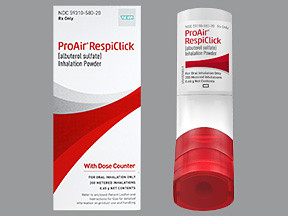ALBUTEROL (SALBUTAMOL) BREATH-ACTIVATED INHALER - ORAL
PHONETIC PRONUNCIATION: (al-BUE-ter-ol/sal-BUE-ta-mol)
COMMON BRAND NAME(S): ProAir RespiClick
GENERIC NAME(S): albuterol sulfate
Uses
USES: Albuterol (also known as salbutamol) is used to prevent and treat wheezing and shortness of breath caused by breathing problems (such as asthma, chronic obstructive pulmonary disease). It is also used to prevent asthma brought on by exercise. It is a quick-relief medication. Albuterol belongs to a class of drugs known as bronchodilators. It works in the airways by opening breathing passages and relaxing muscles. Controlling symptoms of breathing problems can decrease time lost from work or school.
How to use ALBUTEROL (SALBUTAMOL) BREATH-ACTIVATED INHALER - ORAL
HOW TO USE: Read the Patient Information Leaflet provided by your pharmacist before you start using this medication and each time you get a refill. Follow the illustrated directions for the proper use of this medication. If you have any questions, ask your doctor or pharmacist. Inhale this medication by mouth as directed by your doctor, usually every 4 to 6 hours as needed. The dosage is based on your medical condition and response to treatment. Do not increase your dose or use this drug more often than prescribed without your doctor's approval. Using too much of this medication will increase your risk of serious (possibly fatal) side effects. If you are using this medication to prevent asthma brought on by exercise, use it 15 to 30 minutes before exercise. Do not use a spacer with this inhaler and do not open the cap unless you are ready to take a dose. Before use, hold the inhaler upright and open the cap. You should hear a click, which means the inhaler is ready for use. Place the mouthpiece near your mouth and breathe out as far as is comfortable. Do not breathe into the inhaler device. Then put the mouthpiece in your mouth, close your lips around it, and breathe in steadily and deeply. Hold your breath for about 10 seconds, or for as long as is comfortable. Close the cap after each use. Clean the outside of the mouthpiece with a dry tissue or cloth as needed. Do not use water or any other liquid for cleaning. If liquid gets into the inhaler, it may not work properly. If a child is using this medication, a parent or other responsible adult may need to help the child use the inhaler properly. If you are using other inhalers at the same time, wait at least 1 minute between the use of each medication. Always have this quick-relief inhaler with you. Keep track of the number of inhalations used from each device. Discard the device after you have used the number of inhalations marked on the manufacturer's package. Learn which of your inhalers you should use every day (controller drugs) and which you should use if your breathing suddenly worsens (quick-relief drugs). Ask your doctor ahead of time what you should do if you have new or worsening cough or shortness of breath, wheezing, increased sputum, worsening peak flow meter readings, waking up at night with trouble breathing, if you use your quick-relief inhaler more often (more than 2 days a week), or if your quick-relief inhaler does not seem to be working well. Learn when you can treat sudden breathing problems by yourself and when you must get medical help right away. Tell your doctor if your symptoms do not improve or if they worsen.
Side Effects
Precautions
Interactions
Overdose
Images
Reviews
Faq for ALBUTEROL (SALBUTAMOL) BREATH-ACTIVATED INHALER - ORAL
An albuterol breath-activated inhaler is a medication device used to treat asthma and other respiratory conditions. It delivers a predetermined dose of albuterol (also known as salbutamol) when the patient breathes in.
The inhaler contains a canister filled with albuterol, a bronchodilator medication. When the patient inhales through the device, it releases a dose of albuterol, which relaxes the muscles in the airways and allows better airflow into the lungs.
Albuterol (salbutamol) is primarily used to relieve symptoms of asthma, such as wheezing, shortness of breath, and coughing. It can also be used to prevent exercise-induced bronchospasm.
When used as directed, the albuterol breath-activated inhaler is generally considered safe. However, like any medication, it may cause side effects in some individuals. Common side effects include fast or irregular heartbeat, tremors, headaches, and nervousness. It is important to consult a healthcare professional for personalized advice.
The frequency of using the inhaler depends on your healthcare provider's instructions. Generally, it is recommended to use it as needed when experiencing asthma symptoms. It is crucial to follow the prescribed dosage and not exceed the recommended amount.
The albuterol breath-activated inhaler is primarily indicated for asthma and may not be the most appropriate treatment for a simple cough. Consult a healthcare professional to determine the cause of your cough and the most suitable treatment.
It is recommended to discuss the use of any medication, including the albuterol breath-activated inhaler, with a healthcare provider during pregnancy. They will consider the potential risks and benefits to determine if it is safe for you.
The albuterol breath-activated inhaler can be used by children. However, the dosage and frequency may differ based on age and individual circumstances. Follow the healthcare provider's instructions and consult a pediatrician if you have any concerns.
Cleaning and maintenance instructions can vary depending on the specific inhaler model. It is crucial to carefully read and follow the instructions provided with the device. If you have any doubts, consult a healthcare professional or refer to the manufacturer's guidelines.
Disclaimer
IMPORTANT: HOW TO USE THIS INFORMATION: This is a summary and does NOT have all possible information about this product. This information does not assure that this product is safe, effective, or appropriate for you. This information is not individual medical advice and does not substitute for the advice of your health care professional. Always ask your health care professional for complete information about this product and your specific health needs.

No Reviews Yet